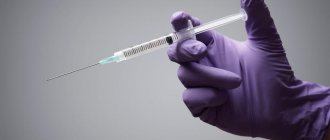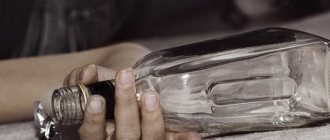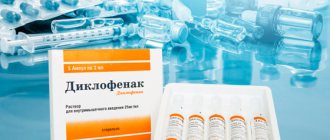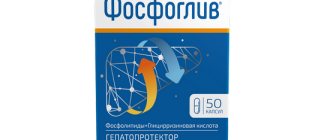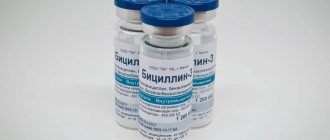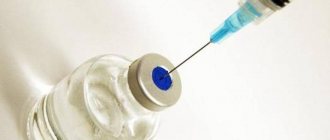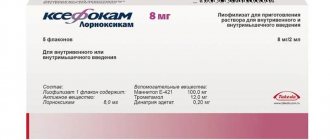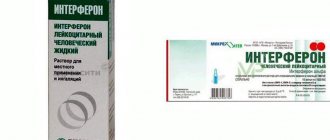The most common side effects of Ceftriaxone are fungal infections in the form of thrush of the oral cavity and genitals, as well as diarrhea due to the development of dysbacteriosis. There is also a risk of allergic reactions - from rashes and itchy skin to life-threatening anaphylactic shock (a sharp drop in blood pressure), swelling of the face and neck, and an attack of suffocation.
When administered for 7 days or more, a blood test is required to detect anemia, signs of decreased coagulation, immunity, and kidney and liver dysfunction. For young children, there is a risk of increased bilirubin in the blood and the formation of salts in the urinary tract and lungs. If any unusual symptoms appear, it is important not to try to eliminate them on your own, but to consult a doctor, as it may be necessary to change the drug or treat complications from the administration of the drug.
Form of production of the drug, composition
The medication in question is classified as an antibiotic. It is produced in powder form. It is intended for intramuscular injection into a vein. The powder is contained inside a glass ampoule. A solution is introduced into this container to dilute the medicine. The manufacturer has thought out different dosages (indicated in grams):
- 0,25;
- 0,5;
- 1;
- 2.
The drug in question is white in color. Possible yellowish tint. The active ingredient is ceftriaxone. This antibiotic is classified as a cephalosporin. Substances differ in their unique structure.
The bactericidal effect of the drug is manifested by suppressing the formation of peptidoglycan. This substance is a component of the shell of microorganisms. Its absence provokes destruction of the shell. Damage leads to the death of the microorganism; it is unable to function with them.
There is no tablet form of Ceftriaxone. The active substance irritates the gastrointestinal tract tissue. Antibiotic analogues may be prescribed in tablet form.
Indications for use
The medicine in question has a bactericidal effect. It was created in the third generation of cephalosporins. The drug is considered one of the most effective in the treatment of infections caused by bacteria. The medicine is used in the treatment of diseases caused by the following bacteria that are sensitive to the substance:
- gram + aerobes;
- gram aerobes;
- anaerobes.
The active substance also has an effect on Shigella, Salmonella, Citrobacter, Providence. There are a number of bacteria that are not affected by the medication in question. Among them:
- streptococci D;
- a large number of Enterococci.
The drug Ceftriaxone has the following indications for use:
- sepsis;
- sinusitis;
- epiglottitis;
- septicemia caused by bacteria;
- infection inside the peritoneum. Such pathologies include angiocholitis, peritonitis;
- syphilis;
- infectious respiratory diseases (bronchitis, pulmonary abscess, pleural empyema, pneumonia);
- meningitis of bacterial origin;
- bacterial damage to the musculoskeletal system;
- infection that penetrated through burns, wounds;
- dermatological pathologies of infectious nature;
- typhoid infection;
- infectious lesions of the maxillofacial area;
- in gynecology these are the following pathologies: prostatitis, pyelitis, epididymitis, pyelonephritis, cystitis;
- chancroid;
- endocarditis, which is caused by bacteria;
- Lyme disease;
- damage to the ENT organs, which is characterized by an infectious nature (otitis media, sore throat, inflammation of the maxillary sinuses);
- carriage of salmonella;
- damage to the body by salmonellosis;
- gonorrhea.
Before injecting Ceftriaxone, a culture is performed. It is needed to determine sensitivity. When a positive reaction to the active substance is detected, a therapeutic course with this medication is prescribed.
WE RECOMMEND THE ARTICLE!
5-NOK effectively copes with pathogenic bacteria that have entered the human genitourinary system. Read more >>
Ceftriaxone can be taken during pregnancy only if it has been prescribed to you by your doctor. This usually only happens in situations where the benefits of its use outweigh the potential risks to the child.
Precautions for children
When treating children with Ceftriaxone, specific risks are taken into account:
- overdose with a combination of kidney and liver diseases (you need to conduct a blood test and reduce the dose if their function is insufficient);
- dysbacteriosis and severe intestinal dysfunction (diarrhea cannot be treated independently using traditional methods or fixatives before examination);
- reducing the immune reaction (after a course of injections, the child should be protected from contact with people who have viral infections, hypothermia, and if necessary, immunostimulants are prescribed);
- decreased blood clotting (if there are problems with the intestines, the level of vitamin K drops, so it must be taken as part of vitamin complexes);
- dehydration (the child should drink as much water, fruit drinks, fresh juices, dried fruit and berry compote as possible);
- digestive disorders (the diet should be gentle, boiled vegetables, steamed meatballs, scrambled eggs, non-sour cottage cheese, baked apples are recommended);
- thrush (it is recommended to limit sweets in the diet);
- dysbacteriosis (for preventive purposes, you need to prepare homemade yoghurts, kefir with pharmaceutical starter cultures).
Instructions for use
It is allowed to prescribe antibiotic injections from the age of one year. The medication helps in the treatment of bronchitis and pneumonia, when diseases pose a threat to the health of children. The danger in these diseases is present due to the rapid manifestation of complications and the specific structure of the respiratory system of children.
It is prohibited to self-prescribe medication to young children.
The instructions contain dosage instructions for patients over 12 years of age. The therapeutic dose is the same for everyone. The dosage for young patients is prescribed by the attending physician, taking into account the child’s condition and weight.
Adults are prescribed 1 - 2 g of medication per day. It is administered once. An injection may be prescribed once every 12 hours. In this case, half the portion is administered. If the pathogen shows resistance to the active substance, it is possible to use a larger amount. 4 g are administered.
The duration of the therapeutic course is prescribed by the attending physician in each case individually. It all depends on the causative agent of the disease and the characteristics of the pathology. If the disease is caused by microorganisms of the genus Neisseria, the therapeutic effect will be achieved in 4 days. When damage to Enterobacteriaceae is observed, therapy takes about 10 - 14 days.
Antibiotic for adnexitis: how to inject
For adnexitis, the antibiotic Ceftriaxone should be injected intramuscularly, 1 g every 12 hours (2 times a day) for 10 days. After the first week of use, the patient comes for an examination and takes tests; based on their results, the doctor can:
- stop the drug;
- extend its administration to 2 weeks;
- add another antibiotic and/or Metronidazole;
- prescribe an antifungal agent (Fluconazole) to prevent thrush;
- recommend lactobacilli (Lactonorm) to restore microflora in the vagina.
Methods of drug administration
The medication is administered in two ways: into a vein or into muscle fibers. Doctors choose an option depending on the disease and the patient’s condition. The effect appears much faster when the medicine is injected into a vein.
The medicine is diluted in different ways:
- lidocaine;
- novocaine;
- water for injections.
Lidocaine is usually used when the drug is administered through a muscle. An anesthetic substance reduces the pain from the injection. When a medication is injected into a vein, it is diluted with saline solution. This method is used if the patient has allergies. The water must be sterile. This is necessary to prevent the penetration of a secondary infection that is resistant to the substance used.
Doctors themselves determine the treatment method, based on the pathogen and the characteristics of the pathology:
- For gonorrhea, 250 g of the drug is prescribed. The injection is performed inside the muscle. The drug is administered once.
- To cure meningitis, the drug is calculated as follows: per 1 kg. 100 mg. medications. More than 4 g should not be prescribed.
- When a positive effect is observed, the dose is reduced. For prophylaxis or before an upcoming operation, 1 - 2 g of the drug is administered.
When the baby turns 14 days old, he can be administered the medication once a day. The dose is calculated as follows: per 1 kg. 20 - 50 mg. Do not use more than 50 mg per day.
For patients under 12 years of age, the dose is determined by weight. The amount of medicine can increase to 75 mg. When a small patient weighs more than 50 kg, he is prescribed the usual dosage. If more than 50 mg/kg is required, administer intravenously. Pour in slowly using a dropper. The procedure lasts from 30 minutes. In this case, the medication is diluted with saline solution.
Typically, lidocaine is used to dilute the drug with water for injections. Divide the composition into 2 parts. The prepared mixture can be stored for no longer than 6 hours.
Children are prohibited from diluting the medication with anesthetics, so as not to cause convulsions and anaphylaxis.
Children are prescribed only Ceftriaxone with water for injection, distilled liquid. The medicine is administered very slowly. This allows the baby to experience a minimum of discomfort. For 1 g of medication take 10 ml.
To give injections to adult patients inside the muscle fibers, use a 4-cc needle. An injection is given in the buttock. The needle is not inserted to the level of the dermis by 2 - 3 mm. More than 1 g of medication is not injected into the muscles.
When can Ceftriaxone be diluted with saline solution?
The main use of saline solution for diluting Ceftriaxone is as an intravenous injection or drip. This is because 0.9% sodium chloride solution has the same salt concentration as blood. That's why it is also called isotonic. It does not disturb the water-salt balance and maintains normal osmotic blood pressure. Saline solution is also needed to refill the nebulizer if Ceftriaxone is recommended for inhalation.
In all other cases, the use of 0.9% sodium chloride solution is not essential. For an injection into a muscle or external use of an antibiotic (for example, treating a purulent wound), you can dissolve the powder with water for injection. Usually, when prescribing a drug, the doctor must indicate the required type of solvent.
Ceftriaxone
Saline
Contraindications for use
The drug in question is not prescribed to patients up to 12 weeks. gestation of the fetus. Its use is dangerous due to changes in the embryo. After 12 weeks the use of the medicine is permitted. Doctors recommend choosing a substitute. When the patient is breastfeeding, the baby is provided with artificial nutrition for the duration of therapy.
Ceftriaxone is considered a potent drug. It has a fairly large list of contraindications:
- prematurity of the baby;
- allergy to cephalosporins;
- lactation period;
- high level of bilirubin in the blood of the newborn;
- enteritis, nonspecific ulcerative colitis;
- renal, liver failure.
If the patient has at least one of the listed contraindications, Ceftriaxone is not used. The doctor selects another analogue of the medication.
special instructions
With simultaneous severe renal and liver failure, in patients on hemodialysis, the concentration of the drug in plasma should be regularly determined. With long-term treatment, it is necessary to regularly monitor the peripheral blood picture, indicators of the functional state of the liver and kidneys. In rare cases, ultrasound of the gallbladder reveals darkening, which disappears after cessation of treatment. Even if this phenomenon is accompanied by pain in the right hypochondrium, continued antibiotic administration and symptomatic treatment are recommended. During treatment, the use of ethanol is contraindicated - disulfiram-like effects are possible (facial hyperemia, spasms in the abdomen and stomach, nausea, vomiting, headache, decreased blood pressure, tachycardia, shortness of breath). Freshly prepared solutions of ceftriaxone are physically and chemically stable for 6 hours at room temperature. During pregnancy, it is used only if the expected benefit to the mother outweighs the risk to the fetus. If it is necessary to prescribe the drug during lactation, breastfeeding should be stopped. Elderly and debilitated patients may require vitamin K.
Side effects in adults
Even the correct use of Ceftriaxone can cause side effects in adults. Among the side effects, patients may experience the following:
- Allergic reactions
. They are represented by fever, anaphylaxis, itching of the dermis, rash, serum sickness, erythema, chills, and an increase in blood eosinophils. - Oliguria
. The condition is represented by a decrease in the amount of urine excreted. - Malfunctions of the gastrointestinal tract
. They are represented by taste perversions, glossitis, nausea, false cholelithiasis, diarrhea, vomiting, candidiasis, stomatitis, enterocolitis. - Pathologies of the hematopoietic organs
. These may include an increase in the number of leukocytes, anemia, the presence of blood in the urine, a decrease in the number of platelets, and heavy bleeding from the nose. - Migraine-like pain
, feeling of dizziness. - Inflammation of the vessel wall
. It manifests itself at the site of intravenous administration of the drug.
Not only antibiotics can cause side effects. A similar reaction is possible to the anesthetic that the doctor used to dilute the medicine.
Signs of an overdose may appear if the dose is chosen incorrectly or exceeds the permissible limit. An overdose results in muscle cramps. It is also possible that the nervous system is overexcited. This condition is considered urgent. Here you will need the help of medical workers. This applies primarily to children.
Undesirable combinations
Together with Ceftriaxone, you cannot administer any other drugs in the same syringe, except water for injection and Lidocaine. The simultaneous intake of calcium salts and antibiotics is especially dangerous for a child under 3 years of age.
With this interaction, insoluble calcium salts of Ceftriaxone are formed, they settle in the bile ducts, kidneys and lungs. This may result in temporary changes on ultrasound or x-ray, but fatal forms of this complication due to renal or respiratory failure are also known.
Urolithiasis disease
Undesirable combinations include:
- diuretics (for example, Furosemide);
- non-steroidal anti-inflammatory drugs (Indomethacin, Ibuprofen);
- Aspirin;
- Vancomycin.
Analogues of the drug
When patients have contraindications to the use of Ceftriaxone, the doctor selects an analogue of the drug. A medicine with a similar mechanism of action and therapeutic effect is selected.
Only the attending physician should select an analogue of Ceftriaxone, taking into account the patient’s contraindications.
Analogues have a smaller spectrum of action. They do not have such a powerful effect on the causative agent of the disease as Ceftriaxone. The medication and dosage are selected by the attending physician.
| Analogue | Active substance | Manufacturer | Price |
| Azaran | ceftriaxone | Hemofarm A.D., Serbia | 2300 - 2319 rub. |
| Rocephin | ceftriaxone | Hoffmann la Roche, Switzerland | 446 - 542 rubles |
| Cefaxon | ceftriaxone | Lupine Limited, India | 159 rubles |
| Lendatsin | ceftriaxone | Lek, enterprise comp. Sandoz, Poland/Slovenia | 2153 - 2158 rub. |
| Cephogram | ceftriaxone | Orchid Chemicals and Pharmaceuticals Ltd, India | 200 - 220 rub. |
| Medakson | ceftriaxone | Medokemi LTD, Cyprus | 643 - 733 rub. |
Ceftriaxone is considered one of the strongest antibiotics with a wide spectrum of action. Its use allows you to quickly eliminate many bacterial infections and prevent the development of complications. The medication should be used very carefully. This is due to the risk of side effects. Therefore, it is not recommended to use the medication without a prescription from a specialist.
